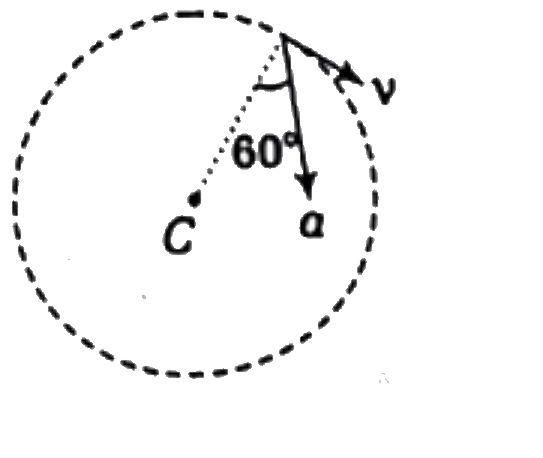A particle is moving on a circular path of radius 0.3 m and rotaing at 1200 rpm. The centripetal acceleration of the particle
4732.60ms−2
47.3260ms−2
4.73260ms−2
473.260ms−2
The correct Answer is:A
To find the centripetal acceleration of a particle moving in a circular path, we can follow these steps:
Step 1: Identify the given values
- Radius of the circular path, r=0.3m
- Rotational speed, n=1200rpm
Step 2: Convert rotational speed from rpm to radians per second
To convert revolutions per minute (rpm) to radians per second, we use the following conversion:
ω=n×2πradians1revolution×1minute60seconds
Substituting the values:
ω=1200×2π60
Calculating this gives:
ω=1200×2π60=1200×π30=40πradians/second
Step 3: Use the formula for centripetal acceleration
The formula for centripetal acceleration ac is given by:
ac=rω2
Substituting the values of r and ω:
ac=0.3×(40π)2
Step 4: Calculate ω2
First, calculate (40π)2:
(40π)2=1600π2
Step 5: Substitute back to find ac
Now substituting back:
ac=0.3×1600π2
ac=480π2
Step 6: Calculate the numerical value
Using π≈3.14:
ac≈480×(3.14)2≈480×9.86≈4728.8m/s2
Final Answer
Thus, the centripetal acceleration of the particle is approximately:
ac≈4728.8m/s2
---
- Radius of the circular path, r=0.3m
- Rotational speed, n=1200rpm
To convert revolutions per minute (rpm) to radians per second, we use the following conversion:
ω=n×2πradians1revolution×1minute60seconds
Substituting the values:
ω=1200×2π60
Calculating this gives:
ω=1200×2π60=1200×π30=40πradians/second
The formula for centripetal acceleration ac is given by:
ac=rω2
Substituting the values of r and ω:
ac=0.3×(40π)2
First, calculate (40π)2:
(40π)2=1600π2
Now substituting back:
ac=0.3×1600π2
ac=480π2
Using π≈3.14:
ac≈480×(3.14)2≈480×9.86≈4728.8m/s2
Thus, the centripetal acceleration of the particle is approximately:
ac≈4728.8m/s2
Topper's Solved these Questions
- BOOK - MHTCET PREVIOUS YEAR PAPERS AND PRACTICE PAPERSCHAPTER - CIRCULAR MOTIONEXERCISE - EXERCISE 154videos
CIRCULAR MOTION
- BOOK - MHTCET PREVIOUS YEAR PAPERS AND PRACTICE PAPERSCHAPTER - CIRCULAR MOTIONEXERCISE - EXERCISE 2 (Miscellaneous Problems)25videos
CIRCULAR MOTION
- BOOK - MHTCET PREVIOUS YEAR PAPERS AND PRACTICE PAPERSCHAPTER - ATOMS, MOLECULES AND NUCLEI EXERCISE - MHT CET Corner30videos
ATOMS, MOLECULES AND NUCLEI
- BOOK - MHTCET PREVIOUS YEAR PAPERS AND PRACTICE PAPERSCHAPTER - COMMUNICATION SYSTEMEXERCISE - MHC CET Corner6videos
COMMUNICATION SYSTEM
Similar Questions
A particle is moving on a circular path of radius 1m. It starts from rest,its tangential acceleration is √3t .The time after which the acceleration of the particle makes an angle of 30∘ with centripetal acceleration is (n)23s .Find the value of n.
View SolutionA particle is revolving in a circular path of radius 2 m with constant angular speed 4 rad/s. The angular acceleration of particle is
View Solution
Knowledge Check
- Question 1 - Select One
A particle moving in a circular path of radius (r) with velocity (V), Then centripetal acceleration of the particle is
AV2rBrV2CVrDV2r - Question 2 - Select One
A particle moving in a circular path of radius (r) with velocity (V), Then centripetal acceleration of the particle is
AV2rBrV2CVrDV2r - Question 3 - Select One
A particle of mass m is moving on a circular path of radius r . Centripetal acceleration of the particle or radius r . Centripetal acceleration of the particle depends on time t according to relation ac=kt2 . What power is delievered to the particle ?
AmrktBmrkt2Cmr2ktDzero
A particle is revolving in a circular path of radius 25m with constant angular speed 12 rev/min.Then the angular acceleration of the particle is?
View SolutionA particle completes 3 revolutions per second on a circular path of radius 8 cm. Find the values of angular velocity and centripetal acceleration of the particle -
View SolutionThe figure shows the total acceleration a=32ms−2 of a moving particle moving clockwise in a circle of radius R = 1 m . What are the centripetal acceleration a and speed of the particle at the given instant ?
 View Solution
View SolutionA particle is moving along circular path of radius 40 m with a uniform speed of 20m/s. Then the time taken for the particle to complete half revolution will be
View SolutionA particle is moving along a circular path of radius 6 m with uniform speed of 8 ms–1. The average acceleration when the particle completes one half of the revolution is -
View Solution

